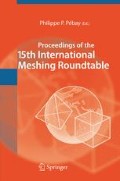Abstract
For a variety of structural finite element analyses on automotive body panels, aerospace wings and space satellite panels, high-quality, structured quadrilateral meshing is imperative. Transfinite meshing, the technique to produce such meshes is severely infringed by the presence of surface-interior point constraints. The present paper attempts to solve the inverse problem of transfinite meshing with interior point cointraints. A modified Newton Raphson based solution is proposed to inverse solve Coons bi-linear blending equation. The Coons parametric coordinates are thus determined for a set of face-interior points from their global coordinates. The boundary of the surface is next seeded with “soft-apoints” at reflected locations and smart-discretized to result in high fidelity, high-quality transfinite meshes.
Access this chapter
Tax calculation will be finalised at checkout
Purchases are for personal use only
Preview
Unable to display preview. Download preview PDF.
References
1. O.C., Zienkiewicz and D. V. Phillips, “An Automatic Mesh Generation Scheme For Plane and Curved Surfaces By Isoparametric Co-ordinates” International J. Numerical Meth. Engg. Vol 3 pp. 519–528 (1971).
2. W.J., Gordon and C.A. Hall, “Construction of curvilinear co-ordinate systems and applications to mesh generation” International J. Numerical Meth. Engg. Vol 7 pp. 461–477 (1973).
3. W.A., Cook, “Body oriented (natural) co-ordinates for generating three-dimensional meshes” International J. Numerical Meth. Engg. Vol 8 pp. 27–43 (1974).
4. Robert, Haber, Mark, S. Shepherd, John, F. Abel, Richard, H. Gallagher and Donald, P. Greenberg “A General Two-Dimensional, Graphical Finite Element Preprocessor Utilizing Discrete Transfinite Mappings” International J. Numerical Meth. Engg. Vol 17 pp. 1015–1044 (1981).
5. R. Pierrot, J. Vazeilles and A. Perronnet, “Une methode de generation d'un maillage 2d ou 3d a' partir d'un maillage grossier” Annales de l'I.T.B.T.P. Nol 372 (May 1979).
6. A. Perronnet, “Logical and physical representation of an object, modularity for the programming of f.e.m.” PDE Software, Interface and Systems, Elsevier Publishers North-Holland IFIP. Soderkoping, Sweden (1984).
7. Alain, Perronnet, “Triangle, tetrahedron, pentahedron transfinite interpolations. Application to the generation of C0 or G1-continuous algebraic meshes” Proc. Int. Conf. Numerical Grid Generation in Computational Field Simulations. Greenwich, England. Vol 7 pp. 467–476 (July6-9,1998).
8. Scott, A. Mitchell, “Choosing Corners of Rectangles for Mapped Meshing” Proc. 13th Annual Symposium on Computational Geometry, ACM Press, pp. 87–93, (June 1997).
9. Scott, A. Mitchell, “High Fidelity Interval Assignment” Proceedings, 6th International Meshing Roundtable, Sandia National Laboratories, pp. 33–44, (October 1997).
10. T.K.H.Tam and Cecil, G. Armstrong, “Finite Element mesh control by integer programming” International J. Numerical Meth. Engg. Vol 36, pp. 2581–2605 (1993).
11. G. Farin, Curves and Surfaces for computer aided geometric design. Academic Press Inc., San Diego, 1990.
12. I.D. Faux and M.J. Pratt, Computational geometry for design and manufacture. Ellis Horwood, Chichester, 1979.
Author information
Authors and Affiliations
Editor information
Editors and Affiliations
Rights and permissions
Copyright information
© 2006 Springer
About this paper
Cite this paper
Mukherjee, N. (2006). High Quality Bi-Linear Transfinite Meshing with Interior Point Constraints. In: Pébay, P.P. (eds) Proceedings of the 15th International Meshing Roundtable. Springer, Berlin, Heidelberg. https://doi.org/10.1007/978-3-540-34958-7_18
Download citation
DOI: https://doi.org/10.1007/978-3-540-34958-7_18
Publisher Name: Springer, Berlin, Heidelberg
Print ISBN: 978-3-540-34957-0
Online ISBN: 978-3-540-34958-7
eBook Packages: EngineeringEngineering (R0)

